Freshwater Fishing, Fisheries Management, and Fishing Access News
In This Issue:
- Big Panfish Initiative (BPI) Update
- Ice Fishing for Yellow Perch
- Greater Niagara Fishing & Outdoor Expo - February 16-19
- Fisheries Staff Spotlight - Justin Brewer, Aquatic Biologist
- Summer Employment Opportunities
Big Panfish Initiative (BPI) Update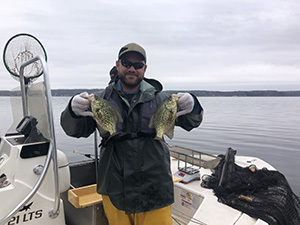
Baseline survey reports and report cards for the first year of the Big Panfish Initiative (BPI) study are now available on our website. The BPI study began in 2021 and is being conducted to determine if the size quality of sunfish (bluegill and pumpkinseed) and crappie fisheries can be improved through the use of conservative harvest regulations. See Sunfish and Crappie Management in New York State for the program update and more information.
2022 sampling data is currently being analyzed and updated report cards should be available later this Spring.
BPI Study Assessment 2021 Interim Report (PDF)
BPI Study Report Cards (PDF)
Ice Fishing for Yellow Perch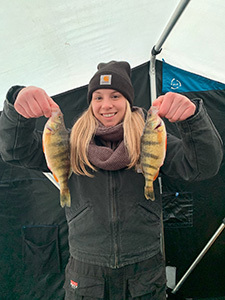
Yellow perch are a common panfish species in New York, so chances are you’ll find them in your local lakes and ponds. You can fish for them year-round, but they’re especially popular during ice fishing season. Not only are they fun to catch, but they are also one of the tastiest freshwater fish!
From shallow weed beds less than 10-feet deep, to flats in 40 feet of water, yellow perch can be found at a range of depths. Tip-ups, or tip-downs, baited with small minnows or jigging with small spoons or jigs tipped with spikes or perch eyes work well. Perch are usually found close to the bottom, so fish within a foot or less from the bottom.
Tips:
- When jigging for yellow perch, try “pounding” your jig into the bottom. This is basically letting your jig hit the bottom on occasion, causing little plumes of bottom sediment. This often attracts perch, as it imitates their feeding on red worms or other bottom dwelling creatures.
- DEC Fisheries staff insider tip: tip-downs seem to be more effective at hooking perch than tip-ups. It can be easier to detect light bites and there’s less resistance when they take the bait.
- Using two hooks baited with small minnows on tip-downs or tip-ups will often catch two yellow perch at the same time.
- When there are multiple perch at/near the bottom, slowly working your jig upwards can separate fish from the bottom and trigger a more aggressive bite.
- Try using medium-sized minnows on tip-ups, as they’re selective for bigger perch.
Greater Niagara Fishing & Outdoor Expo - February 16-19
DEC Bureau of Fisheries will be back at the Niagara Fishing Expo this year to host its popular "Open House" on Saturday, February 18, from 10 a.m. to 2 p.m.
Show attendees can stop by and talk one-on-one with our staff about a variety of fisheries management topics related to Lake Erie, Lake Ontario, Finger Lakes, Niagara River, St. Lawrence River, and more.
In addition to the Open House, DEC will have its annual informational booth, which will be open throughout the event. There will also be a Kids Fishing Clinic held on Sunday, February 19. To sign up for the clinic and for more information visit the Greater Niagara Fishing & Outdoor Expo website.
Fisheries Staff Spotlight - Justin Brewer, Aquatic Biologist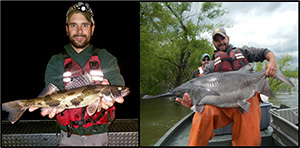
I’m an Aquatic Biologist with DEC’s Bureau of Fisheries working out of the Region 9 Allegany sub-office. Prior to signing on with DEC, I studied Natural Resource Conservation, Conservation Law, and Fisheries at Finger Lakes Community College, and went on to finish my undergrad at SUNY Cobleskill with a B.T. in Fisheries and Aquaculture. While at SUNY Cobleskill, I completed an internship with the US Forest Service on Prince of Wales Island in Southeast, Alaska. Our job was to classify watersheds and delineate riparian stream buffers to protect wild salmonid spawning runs. That experience, coupled with the mentors and colleagues I met along the way, reinforced my interest in natural resource conservation and played a vital role in guiding my career path.
My career with DEC began in 2011 after a spontaneous visit to the Allegany office to “talk to someone in fisheries about job openings”. I’m telling this story because I later learned that these jobs are not easy to come by (and I apparently had a lucky horseshoe that day). With nothing but a resume and eager attitude to work with fish, I walked in and was greeted by one of my current co-workers who also happened to be the Principal Fisheries Technician in charge of hiring seasonal technicians for the unit. After a brief, impromptu interview about my background and experience, he mentioned that a long term seasonal had left the day before, and two days later I was offered the position. Five years as a dedicated seasonal technician finally paid off in 2016 when I was hired as a biologist in the very same office. While this situation is rare, I hope it serves as a reminder to anyone searching for a career in this field, that opportunities can arise when you least expect it; stay optimistic, enthusiastic, and dedicated and you will eventually find your calling.
My primary role in Region 9 Fisheries is managing our warmwater inland fisheries resources, including the Allegheny River system, Chautauqua Lake, and several other small lakes and streams in Western NY. During the field season, our fisheries unit (I couldn’t do any of this without our extraordinary staff) conducts a variety of surveys to monitor fish populations, including electrofishing, trap netting, gill netting, bottom trawling, seining, acoustic telemetry, and angler surveys. I’m also involved with monitoring and restoration programs for rare, threatened, and endangered fish species in the southern part of the region, particularly in the Allegheny River. I’ve had the opportunity to work on recovery programs for paddlefish, sauger, and gilt darter, historically native species that are now listed as threatened or endangered in NY. I also occasionally join the crew for coldwater trout stream surveys and habitat improvement projects, a major component of our fisheries program.
Every spring I look forward to teaming up with the Chautauqua Fish Hatchery for our muskellunge trap net survey and egg take, where we monitor the population and collect muskie eggs that are eventually stocked across the state. Another gratifying memory is working with the Niagara Musky Association on an acoustic tracking study with muskies in Buffalo Harbor on Lake Erie. As an avid angler myself, one of the most satisfying parts of being a DEC biologist is talking with anglers, guides, and fishing groups who share the same appreciation for our fisheries resources.
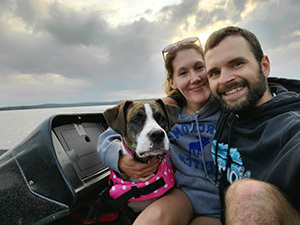 A great bonus for me is having the privilege to work on the waters I grew up fishing and playing on. I credit my parents, grandparents, and relatives for introducing me to fishing and the outdoors since I was old enough to hold a fishing rod. I didn’t know it then, but this ultimately instilled my passion for fish, and inspired me to influence and teach others about fishing and the outdoors. I enjoy spending my spare time with family and friends, typically fishing, traveling (and fishing), hiking, gardening or just about anything outdoors. Aside from fishing, I’m passionate about my hunting heritage and enjoy many hours in the woods during the fall. When we aren’t with family or friends, I can usually be found adventuring and spending time with my girlfriend Ally, and our dog Iris, who luckily for me both love being on the water! A great bonus for me is having the privilege to work on the waters I grew up fishing and playing on. I credit my parents, grandparents, and relatives for introducing me to fishing and the outdoors since I was old enough to hold a fishing rod. I didn’t know it then, but this ultimately instilled my passion for fish, and inspired me to influence and teach others about fishing and the outdoors. I enjoy spending my spare time with family and friends, typically fishing, traveling (and fishing), hiking, gardening or just about anything outdoors. Aside from fishing, I’m passionate about my hunting heritage and enjoy many hours in the woods during the fall. When we aren’t with family or friends, I can usually be found adventuring and spending time with my girlfriend Ally, and our dog Iris, who luckily for me both love being on the water!
Summer Employment Opportunities
Would you like to work in New York State's beautiful Adirondack and Catskill Forest Preserves this summer?
2023 Summer Camps Program
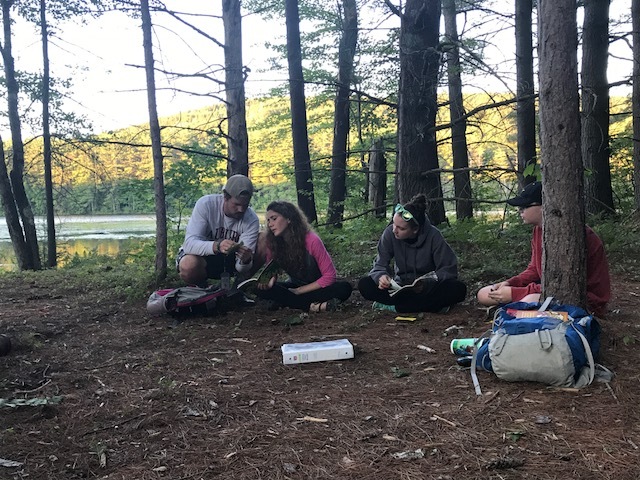
We are actively recruiting Directors, Assistant Directors, Waterfront Directors, Cooks, Nurses, EMTs, Counselors, and Camp Aides for the 2023 Summer Camps Program. All positions offer competitive salaries, plus room and board for the summer.
Locations of DEC Summer Camps:
- Camp Colby in Saranac Lake;
- Camp Pack Forest in Warrensburg;
- Camp Rushford in Caneadea; and
- Camp DeBruce, near Livingston Manor.
DEC Summer Camps combine environmental education, hunter education, and outdoor recreation to create an adventurous experience for youth. Camp staff engage campers in ecological principles such as field, forest, aquatic, wildlife, and human impact and outdoor skills including backpacking, camping, and canoeing. Learn more about the employment opportunities and how you can apply to work at DEC Environmental Education Camps.
DEC Campgrounds and Day-use Areas
Be a part of a team that helps vacationers enjoy the great outdoors in the Catskill Forest Preserve and Adirondack Park. Positions available include Lifeguard, Maintenance, Security, Supervisor, and more! Some positions start as early as May, but varying start dates can be accommodated based on school and work schedules.
For more information on available positions or to apply for a position call 518-457-2500, e-mail campinfo@dec.ny.gov, or visit the Campground Seasonal Employment webpage on DEC's website.
Lifeguard Positions
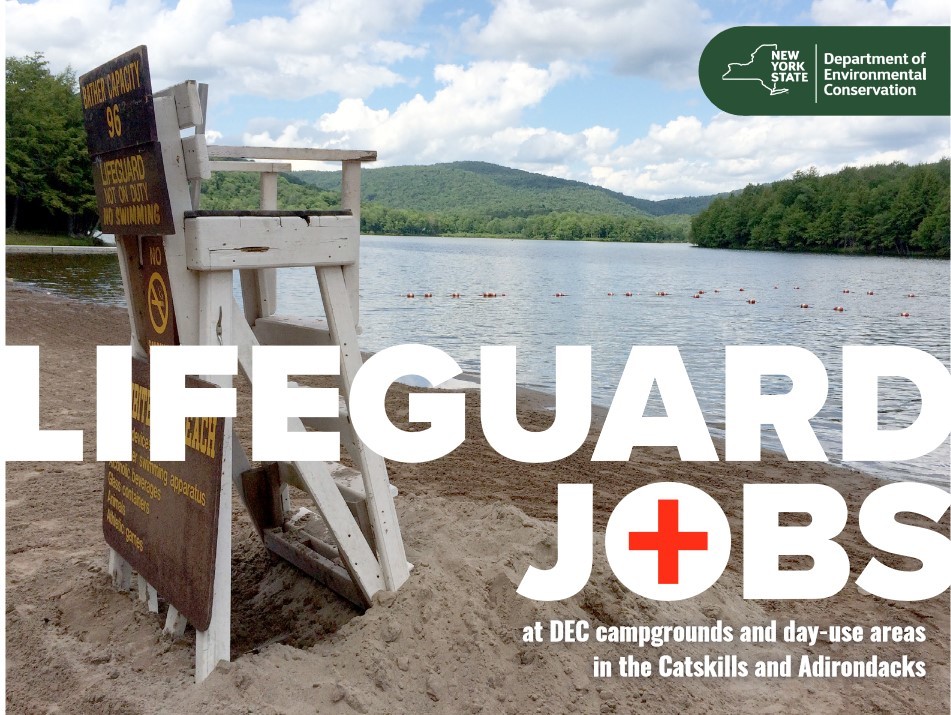
Seasonal lifeguard positions are available at DEC campgrounds. The current hourly starting rate for New York State lifeguards is $20 an hour, and most DEC facilities offer free housing or site accommodations.
Candidates who qualify will be considered for employment. The qualifying procedure consists of two parts: a Cardio-Pulmonary Resuscitation (CPR) skills component; and a water skills evaluation. Candidates may attend the qualifying location most convenient to them and the results will be forwarded to their preferred work location.
At the time of employment, all DEC lifeguards must:
- Be at least 15 years old;
- Possess a valid certification in Waterfront Skills, Lifeguarding, First Aid, and CPR for the Professional Rescuer or equivalent;
- Successfully completed the New York State lifeguard qualifying procedure;
- Submitted a current New York State DEC medical form stating the candidate's physical ability to perform lifeguard duties;
- Meet the vision requirement of 20/70 uncorrected in both eyes and be correctable to the 20/40 standard. Candidates tested at a vision level below 20/40 in either one or both eyes must correct to a minimum of 20/40 with 20/20 preferred;
- Completed a personal interview with DEC; and
- Attended a DEC lifeguard orientation.
For more information, updates, or to pre-register, call 518-457-2500 ext. #1, e-mail Info.Lifeguard@dec.ny.gov, or visit the Lifeguard Positions webpage on DEC's website.
|






 A great bonus for me is having the privilege to work on the waters I grew up fishing and playing on. I credit my parents, grandparents, and relatives for introducing me to fishing and the outdoors since I was old enough to hold a fishing rod. I didn’t know it then, but this ultimately instilled my passion for fish, and inspired me to influence and teach others about fishing and the outdoors. I enjoy spending my spare time with family and friends, typically fishing, traveling (and fishing), hiking, gardening or just about anything outdoors. Aside from fishing, I’m passionate about my hunting heritage and enjoy many hours in the woods during the fall. When we aren’t with family or friends, I can usually be found adventuring and spending time with my girlfriend Ally, and our dog Iris, who luckily for me both love being on the water!
A great bonus for me is having the privilege to work on the waters I grew up fishing and playing on. I credit my parents, grandparents, and relatives for introducing me to fishing and the outdoors since I was old enough to hold a fishing rod. I didn’t know it then, but this ultimately instilled my passion for fish, and inspired me to influence and teach others about fishing and the outdoors. I enjoy spending my spare time with family and friends, typically fishing, traveling (and fishing), hiking, gardening or just about anything outdoors. Aside from fishing, I’m passionate about my hunting heritage and enjoy many hours in the woods during the fall. When we aren’t with family or friends, I can usually be found adventuring and spending time with my girlfriend Ally, and our dog Iris, who luckily for me both love being on the water!
